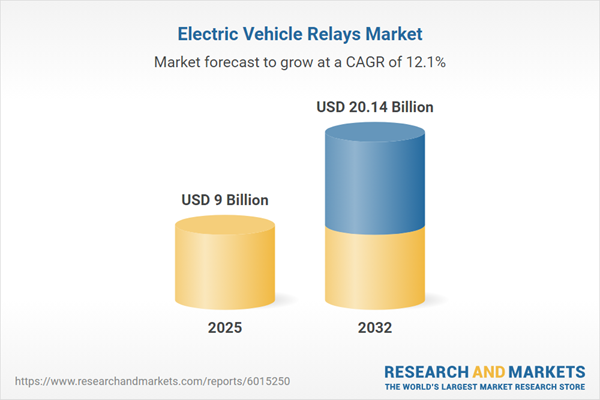Speak directly to the analyst to clarify any post sales queries you may have.
The electric vehicle relays market is at the forefront of enabling reliable power switching and energy management for modern mobility. As sustainability priorities surge across the global automotive sector, relays are central to the advanced electrical architectures powering next-generation electric vehicles.
Market Snapshot: Electric Vehicle Relays Market Size and Growth
The electric vehicle relays market grew from USD 8.07 billion in 2024 to USD 9.00 billion in 2025. The sector is projected to maintain robust momentum with a compound annual growth rate (CAGR) of 12.10%, forecasted to achieve USD 20.14 billion by 2032. This sustained trajectory is driven by intense electrification efforts, expanding EV sales, and increasing requirements for advanced power switching technologies among automotive OEMs and suppliers.
Scope & Segmentation
This report offers a detailed breakdown of the electric vehicle relays market, enabling leaders to pinpoint high-growth segments and align investments. Segmentation is structured across the following dimensions:
- Relay Types: PCB Relay, Plug-in Relay
- Relay Configurations: Double-pole Relays, Multi-pole Relays, Single-pole Relays
- Voltage Types: High Voltage, Low Voltage, Medium Voltage
- Materials: Aluminum-based, Copper-Based Relays, Mixed Metal Relays, Silver-Based Relays, Stainless Steel-based
- Applications: Accessory & Safety Systems, Battery Management Systems (BMS), Charging Systems, Motor Control Systems
- Vehicle Types: Commercial Vehicles, Passenger Vehicles
- End-Users: Aftermarket, Automotive OEMs
- Distribution Channels: Direct Sales, Distribution Networks, Online Sales
- Regions: Americas (United States, Canada, Mexico, Brazil, Argentina, Chile, Colombia, Peru), Europe, Middle East & Africa (including United Kingdom, Germany, France, Russia, Italy, Spain, Netherlands, Sweden, Poland, Switzerland, United Arab Emirates, Saudi Arabia, Qatar, Turkey, Israel, South Africa, Nigeria, Egypt, Kenya), Asia-Pacific (China, India, Japan, Australia, South Korea, Indonesia, Thailand, Malaysia, Singapore, Taiwan)
- Companies Covered: ABB Ltd., American Zettler Inc., Continental AG, Delphi Technologies, DURAKOOL LIMITED, EG Electornics, Fujitsu Limited, HELLA GmbH & Co. KGaA, HIITIO New Energy Co., Ltd, Honeywell International Inc., LS Electric America, Mouser Electronics, Inc., O/E/N India Limited, OMRON Corporation, Panasonic Holdings Corporation, Robert Bosch GmbH, Rockwell Automation, Schneider Electric SE, Siemens AG, Song Chuan Precision Americas Inc., TE Connectivity Ltd., Texas Instruments Incorporated, Toshiba Corporation, Xiamen Hongfa Electroacoustic Co. Ltd.
Key Takeaways for Senior Decision-Makers
- Relays serve as the backbone of power switching and battery management, expanding their role from traditional components to enablers of smart diagnostics and real-time monitoring in advanced EV architectures.
- Technological convergence among magneto-resistive, solid-state, and electromechanical relays is driving the development of hybrid solutions suitable for diverse environments and vehicle functions.
- Automotive OEMs increasingly demand highly integrated relays that meet rigorous standards for electromagnetic compatibility, operational safety, and durability, especially for high-voltage and fast-charging applications.
- Manufacturers are innovating with mixed-metal and silver-alloy contacts to support longevity and enhanced performance in critical circuits, while also focusing on weight-reducing materials for improved vehicle efficiency.
- Regional industry dynamics in Asia-Pacific, North America, and Europe each bring unique opportunities and challenges, from cost optimization and local sourcing to compliance with evolving regulatory frameworks.
- The fast adoption of modular EV platforms and the spread of over-the-air updates underscore the strategic relevance of smart, upgradable relays as the industry transitions toward digitalized, service-oriented business models.
Tariff Impact and Trade Factors
Imposed tariffs on auto components in the United States have introduced notable challenges for relay manufacturers and OEMs. Increased input costs are driving a realignment of sourcing strategies, driving investment in local production. Supply agreements and design optimization using domestic materials are central responses, influencing both cost structures and time to market.
Electric Vehicle Relays Market Methodology & Data Sources
This report leverages both primary and secondary research, including interviews with relay engineers, OEM executives, and supply chain leaders. Multiple data validation rounds ensure reliability, using public filings, corporate disclosures, regulatory sources, and industry consortia. Rigorous internal review guarantees that insights are grounded in observable trends and actionable intelligence.
Why This Report Matters
- Equips industry executives and strategists with granular insights into technology trends, regional risks, and competitive intensity within the electric vehicle relays market.
- Supports better decision-making around sourcing, product development, and market entry by delivering independent, segmented, and actionable data.
Conclusion
The electric vehicle relays market is evolving rapidly, with innovation and regulatory shifts shaping future growth. This report empowers leaders to make informed, agile decisions as the landscape transitions toward more electrified and intelligent transportation systems.
Additional Product Information:
- Purchase of this report includes 1 year online access with quarterly updates.
- This report can be updated on request. Please contact our Customer Experience team using the Ask a Question widget on our website.
Table of Contents
3. Executive Summary
4. Market Overview
7. Cumulative Impact of Artificial Intelligence 2025
Companies Mentioned
The companies profiled in this Electric Vehicle Relays market report include:- ABB Ltd.
- American Zettler Inc.
- Continental AG
- Delphi Technologies
- DURAKOOL LIMITED
- EG Electornics
- Fujitsu Limited
- HELLA GmbH & Co. KGaA
- HIITIO New Energy Co., Ltd
- Honeywell International Inc.
- LS Electric America
- Mouser Electronics, Inc.
- O/E/N India Limited
- OMRON Corporation
- Panasonic Holdings Corporation
- Robert Bosch GmbH
- Rockwell Automation
- Schneider Electric SE
- Siemens AG
- Song Chuan Precision Americas Inc.
- TE Connectivity Ltd.
- Texas Instruments Incorporated
- Toshiba Corporation
- Xiamen Hongfa Electroacoustic Co. Ltd.
Table Information
| Report Attribute | Details |
|---|---|
| No. of Pages | 188 |
| Published | November 2025 |
| Forecast Period | 2025 - 2032 |
| Estimated Market Value ( USD | $ 9 Billion |
| Forecasted Market Value ( USD | $ 20.14 Billion |
| Compound Annual Growth Rate | 12.1% |
| Regions Covered | Global |
| No. of Companies Mentioned | 25 |









